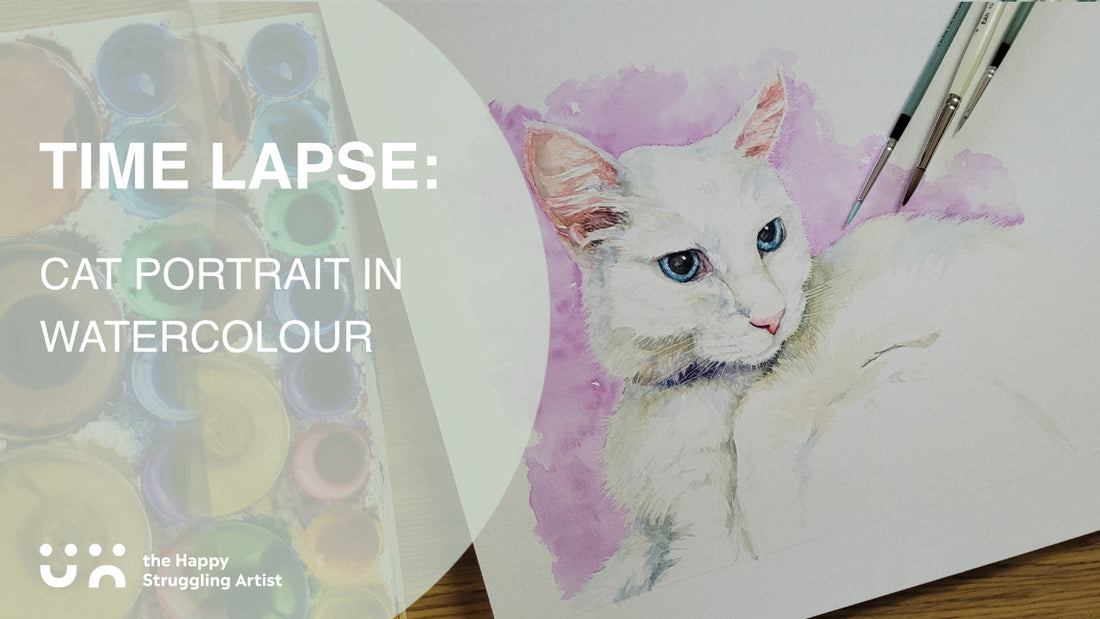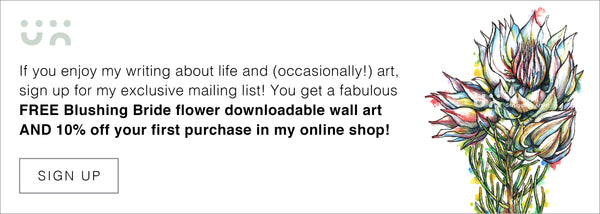
Painting a White Cat (Without Painting It White)
Share
Earlier this year, I shared the story behind a very personal commission that was totally outside my usual scope of work: a memorial portrait of a beloved cat named Icing. It was a deeply meaningful project for many reasons — one that unfolded during a time of quiet heartbreak in my own home. I now want to gently shift the focus from the emotional weight of the portrait to the technical side of creating it, paired with the time lapse video that documents the entire creation process.
The biggest challenge? Icing is a white cat. And in the world of watercolour, that’s not as simple as it sounds.
Although one can purchase a tube of white watercolour, it can't really be used as white. Let me explain that bizarrely contradicting sentence a bit better: Watercolour is a transparent medium. If you paint a layer of blue, allow it to dry, and then add a layer of yellow over it, you would still see the blue through the yellow layer. In fact, each layer you lay down greatly influences the layers on top of it. You may remember from your preschool colouring days that the combination of blue and and yellow make green! Of course you could have just used green paint - LOL! But, this unique attribute of watercolour really makes for artworks that have an amazing depth and ‘alive-ness’. Not only can you create a new colour by applying two separate layers on top of each other, but you can do it in such a way that each one of those layers still show their original colour, too (by not covering the entire first layer, etc). That’s what I mean (almost incoherently!) by ‘alive-ness’!
So, back to the white that can’t white: Since white watercolour is also transparent, it is not really possible to add white details on top of layers that have already been lain down. The white bits would simply never really be white, since the layers below would always show through! You would only purchase that silly little tube of white watercolour in order to mix it with other colours to kind of alter the hue/value of said colour (insert eye-roll here)…
And now you may ask, “but how do you paint a white subject without being able to use white watercolour?”. Good question, Samantha.
The answer is that you have to harness the Power of the Paper (is it just me, or does that sound like a really cool band name?)! Whenever you see white in a watercolour painting, you know that those bits have not been painted at all, allowing the paper to show through.
Side note: Many artist do use non-transparent mediums like gouache, acrylic or a titanium dioxide-pigment-thingy to add white details to watercolour works. Artists also use this liquid gunk called masking fluid to preserve white areas. You paint on the gunk, allow it to dry, then you can happily paint over and around it, and later simply wipe off the masking fluid to reveal the protected white bits. There are many ways to skin a (white) cat!
Back to Icing, the white cat:
To ensure that Icing did not resemble a ghostly cousin of the Cheshire Cat, floating in the void (in other words, to add definition to a white subject on white paper that cannot be painted white), I added the pinkish-purple background.
Side note: Once, at university (while studying Graphic Design), a celebrated Graphic Designer spent some time with us as a guest lecturer. Long story short, we had to present our concept to him and the entire class. Pointing at my design on the computer screen, I said, “…and here I’ll use this pinkish colour”. He said, “that’s purple”. I said, “Okay, pinkish-purple”. He said, “Are you colourblind?”. Everyone laughed. He wasn’t being cruel. He was genuinely concerned about this young, colourblind Graphic Designer...! But, it took a long time to live that down!
Back to Icing, the white cat:
Watercolour 'rules' dictate that one should start with the background first. I say bleh to that — I like starting with my subject’s eyes first. Because I’m a colourblind rebel that enjoys the exhilarating rush of I-may-or-may-not-screw-up-this-entire-painting-by-adding-the-background-last! Seriously, though — I recommend that you start your background first…
Cat and pinkish-purple background complete, I used my favourite technique - 'lifting' - to extend teensy tiny white hairs into the pinkish-purple background. “What’s lifting?", you may ask. Let me tell you, George:
Not only does white watercolour not really exist, its existential crisis get really complex when you add the fact that all the layers already lain down (blue, yellow, pinkish-purple included) come back to life when you add more layers on top of them. Yup. Just like Frankenstein’s Monster. But, before you swear off watercolour as a medium that only nutters should attempt, here’s why this freaky little attribute is cool: Lifting - activating paint on your paper by adding water to to certain areas and gently sucking some of the paint off of your working surface - can be used to create magnificent, minute details and radiant areas of light! It can also be used to fix not-so-horrid-stuff-ups (truly-horrid-stuff-ups are, unfortunately, very unforgiving!). For me, this is the best technique to use for fur, whiskers and feathers - all my favourite things!
And there you have it. Icing, the white cat, and his pinkish-purple background, explained. You’re welcome, Sally.
PS. I’m not colourblind.

